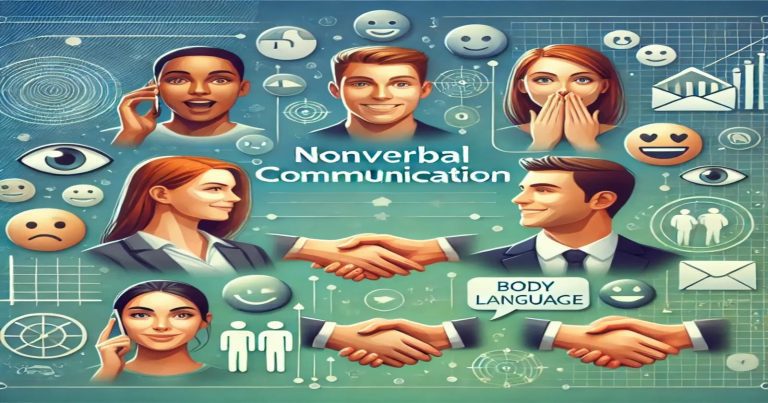Communication plays a significant role in human interaction, through which one can express oneself and share ideas, feelings, and information with others. Nonverbal communication is one of the most significant forms of communication. It is communication that has no use of spoken or written words. Instead, it is made possible through body language, facial expressions, eye contact, a change in the tone and voice of a person, and numerous other gestures, which are all physically generated. People use nonverbal communication in everyday conversations, workplaces, public speaking, and social interactions.
A simple smile may portray happiness, while a frown signifies displeasure and crossed arms signal defensiveness. As such, this becomes a highly significant skill that may enhance interpersonal relations, professional contacts, and social communications. Communication plays a vital role, and understanding it is very important to communicate effectively. It helps one express emotions, reinforce verbal messages, create trust, and avoid misunderstandings.
What is Communication?
Communication is transmitting information, ideas, and emotions between individuals or groups. Communication plays a vital role in human interaction as it allows people to express their thoughts, share experiences, and develop relationships. Without communication, society would have a hard time working because cooperation and understanding would be almost impossible.
People communicate in many ways according to their situation and purpose. It can be in the form of oral or written words, gestures, body language, or facial expressions. Effective communication aids in implementing education, business, healthcare, or everyday activities. Every time a teacher teaches a lesson to the students, a doctor prescribes a patient or a manager guides the employees, communication will give them proper information.
Types of Communication
Communication can be categorized broadly based on the methods with which messages are transferred. It can be basically classified into two types of communication: verbal and nonverbal. Although they are both required to carry out the human communication system, they do have different working methods and aims.
Verbal Communication
The expression of messages that uses verbal words-spoken or written-constitutes verbal communication. These can be face-to-face conversations, phone calls, speeches, presentations, emails, letters, and text messages. This method of communication will ensure that ideas are conveyed clearly and can be used to exchange detailed information.
Effective verbal communication involves good vocabulary, pronunciation, tone, and clarity. How one conveys his message when speaking is based on tone of voice and pitch. In the case of written communication, grammar, punctuation, and structure determine the clarity of the message.
Nonverbal Communication
Nonverbal communication does not rely on words. It uses body language, facial expressions, gestures, eye contact, posture, and even the tone of voice to convey meaning. Nonverbal messages often supplement or negate verbal messages. For example, a person can say they are happy, but if he looks sad, the nonverbal message is otherwise.
Nonverbal Communication
Nonverbal communication is the passing of information through physical means rather than words or written language. It involves various behaviours that communicate emotions, attitudes, and intentions. People use nonverbal communication every day, usually without even knowing it. From a nod to a firm handshake or avoiding eye contact, nonverbal signals influence how messages are interpreted.
One of the most important aspects of nonverbal communication is that it can express emotions more accurately than words. People may say they are fine, but their facial expressions and body posture might suggest otherwise. This makes nonverbal communication a more honest form of expression, as people may try to control their words but often reveal their true feelings through body language.
Nonverbal Communication Examples
There are a lot of examples of nonverbal communication which people use to communicate in their day-to-day activities. The common examples include facial expressions, in which one shows being happy with a smile or feeling sad and discontented with frowning; gestures of waving, pointing, or giving a thumbs-up to get the message across; and eye contact gives an impression that one is feeling confident and listening when direct eye contact is being maintained and feels nervous or telling lies when they avoid it.
- Posture: Sitting upright indicates interest and attention, but slouching can imply boredom or a lack of interest.
- Tone of Voice: Pronunciation of words will bring different tones, such as excitement, frustration, or sarcasm.
All these examples of nonverbal communication show how people speak without words. They certainly give insight into the state of a person’s thoughts, attitudes, and emotions.
Types of Nonverbal Communication
There are different types of nonverbal communication, each with a different purpose. The knowledge of these types will help in the correct interpretation of messages. The primary types of nonverbal communication are as follows:
- Kinesics (Body Language): These are the body’s movements, such as gestures and posture. Handshakes, crossed arms, and nodding.
- Facial Expressions: They express emotions such as happiness, anger, or surprise. A smile indicates friendliness, while a frown indicates disapproval.
- Eye Contact: This shows interest, confidence, or nervousness. Lack of eye contact may indicate deception or discomfort.
- Proxemics (Personal Space): The space between people when communicating. Nearness is a sign of friendship, and distance is a sign of formality.
- Paralinguistics (Vocal Cues): Tone, pitch, and rate of voice. A loud tone may indicate anger, while a soft tone indicates politeness.
- Haptics (Touch): Physical contact, such as handshakes and hugs. A firm handshake can denote confidence, while a soft touch can be a way of showing affection.
What is Difference Between Verbal and NonVerbal Communication?
Verbal and nonverbal communication are two different kinds of communication. Verbal communication is the basis of words, while nonverbal communication is based on physical signals. Here’s a comparison of the main differences between them:
| Feature | Verbal Communication | Nonverbal Communication |
| Uses Words | Yes | No |
| Forms | Spoken, Written | Gestures, Facial Expressions |
| Clarity | High | Sometimes Unclear |
| Cultural Impact | Can be Translated | Varies Across Cultures |
| Documentation | Possible | Not Possible |
Nonverbal Communication FAQs
What are the barriers of communication?
Language differences, cultural variations, and misinterpretations form barriers of communication.
What is the means of communication?
There are four forms of communication, namely verbal, nonverbal, written, and electronic methods.
What is the difference between verbal and nonverbal communication?
Verbal communication uses words, while nonverbal communication uses gestures and facial expressions.
What are nonverbal communication examples?
Nonverbal Communication includes reports and memos.
What are the different types of nonverbal communication?
Visual and written communication are the types of nonverbal communication.


